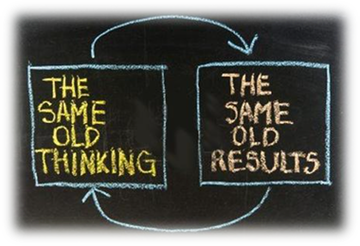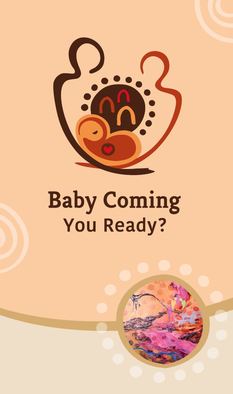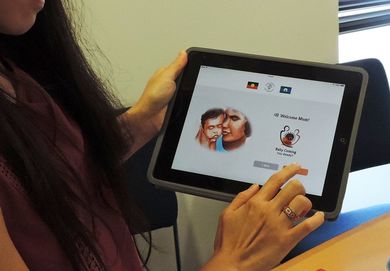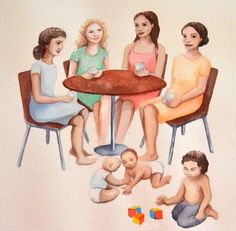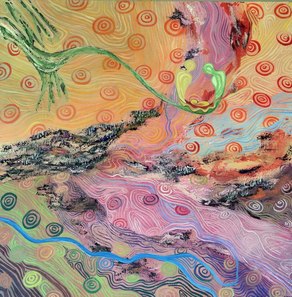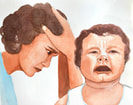.... baby coming - you ready?'.... |
|
|
Albert Einstein was credited with saying:
"Insanity is doing the same thing over and over again and expecting different results." He was also credited with saying: “Information is not knowledge…the only source of knowledge is experience.” 'Baby Coming-You Ready?' is the result of listening to and learning from the knowledge and experience of Aboriginal people. it is an innovative approach to screening and assessing perinatal mental health and wellbeing. |
'baby coming - you readY?'
|
The 'Baby Coming - You Ready?' rubric**is a new culturally secure approach to supporting the social and emotional wellbeing of Aboriginal and Torres Strait Islander mothers and fathers before and after baby comes
It emerged from the recent 'Kalyakool Moort' research project.
Designed to be initiated ideally during pregnancy, it results in a self directed 'plan' that becomes a living-journey supporting and strengthen family throughout those first 1000 days. ** Rubric: a process of assessment that is shared between client and clinician, that integrates both process and outcome indicators, and whose purpose is to bring clarity to complex situations through integrated consideration of multiple features. This encourages self-evaluation and reflection and fosters understanding for both users.
|
|
How is it different from other mental health screening tools?
The 'Baby Coming-You Ready?' rubric:
|
Additionally it:
- Utilizes specific evidence-based procedures: brief intervention, SMART goal setting and motivational interviewing techniques.
- Minimizes report writing and maximizes face-to-face time with the mother-to-be.
- Ensures culturally safe, timely, family-centered followup.
- Increases a sense of ownership, personal-control and empowerment.
- Provides access to culturally relevant engaging parenting information, resources and education via the 'Baby Coming-You Ready?' Aboriginal Parenting web-site.
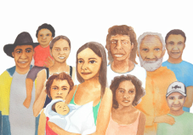 Strong Mothers & Strong Fathers make Strong Families & Strong Communities
Strong Mothers & Strong Fathers make Strong Families & Strong Communities
How will 'Baby Coming-You Ready?' work?
It does much more than screen for perinatal depression.
Visual images on a touch screen device where images portray emotions, circumstances and events, both positive and challenging, that a mother (or father-to-be) may have experienced or be experiencing.
These images guide both the clinician and the parent-to-be through specific domains of inquiry in a relaxed, fun and engaging manner. Using strength-based inquiry, the parent engages in an individualized exploration of her/his own social and emotional wellbeing. As images are selected they automatically populate the parent's own visual story, capturing protective and strengthening aspects in her/his world, and identifying anything that might be making life stressful.
Aboriginal people are deeply resilient.
However historic trauma with accumulative stressors take their toll, particularly during pregnancy.
So the rubric has been designed to assesses and creates a visual portrayal of the degree of distress the parent-to-be may be experiencing as a result of mounting stressors.
This helps to make sense of and motivate what follows: the jointly developed and personalized management plan that continues throughout the pregnancy and beyond. As images were selected, they automatically populate the basic framework for an emerging personalized management plan using strengths that can be built on and problems have been identified.
The most pressing problems are addressed using SMART** goals and are followup during the pregnancy as the 'Baby Coming-You Ready?' journey continues.
Finally and importantly, it provides a framework to connect the mother/father-to-be to a strong local 'champion' within the Aboriginal community who will be engaged to support the parent in achieving her/his goals and 'walk along side' as she/he grows in the parenting journey.
Once the management plan is completed the health professional will receive an automatically interpreted summary into her clinical file, while the parent (if desired) will receive the personalized, password protected plan their mobile device. Highly secure technology is utilised for this purpose through one of our key project partners: the Center of Perinatal Excellence (COPE)
It does much more than screen for perinatal depression.
Visual images on a touch screen device where images portray emotions, circumstances and events, both positive and challenging, that a mother (or father-to-be) may have experienced or be experiencing.
These images guide both the clinician and the parent-to-be through specific domains of inquiry in a relaxed, fun and engaging manner. Using strength-based inquiry, the parent engages in an individualized exploration of her/his own social and emotional wellbeing. As images are selected they automatically populate the parent's own visual story, capturing protective and strengthening aspects in her/his world, and identifying anything that might be making life stressful.
Aboriginal people are deeply resilient.
However historic trauma with accumulative stressors take their toll, particularly during pregnancy.
So the rubric has been designed to assesses and creates a visual portrayal of the degree of distress the parent-to-be may be experiencing as a result of mounting stressors.
This helps to make sense of and motivate what follows: the jointly developed and personalized management plan that continues throughout the pregnancy and beyond. As images were selected, they automatically populate the basic framework for an emerging personalized management plan using strengths that can be built on and problems have been identified.
The most pressing problems are addressed using SMART** goals and are followup during the pregnancy as the 'Baby Coming-You Ready?' journey continues.
Finally and importantly, it provides a framework to connect the mother/father-to-be to a strong local 'champion' within the Aboriginal community who will be engaged to support the parent in achieving her/his goals and 'walk along side' as she/he grows in the parenting journey.
Once the management plan is completed the health professional will receive an automatically interpreted summary into her clinical file, while the parent (if desired) will receive the personalized, password protected plan their mobile device. Highly secure technology is utilised for this purpose through one of our key project partners: the Center of Perinatal Excellence (COPE)
** SMART goals: Specific, Measurable/Motivational, Achievable/Agreed upon, Realistic, Time-framed.
|
How is 'Baby Coming-You Ready?' scored or rated?
The 'Baby Coming-You Ready?' rubric does not rely on a numerical score which determines the referral response; nor is the outcome focused on 'risk'. Rather it creates a framework whereby the parent-to-be and the midwife jointly identify how soon the follow-up occurs i.e:
|
How will I be able to access and utilize 'Baby Coming-You Ready?' within my workplace?
Following completion of this 2 year pilot (commencing September 2018 ), interested organizations register to utilize the 'Baby Coming-You Ready?' rubric, the app will be easily accessible via the specific 'Baby Coming-You Ready?' Aboriginal Parenting website. From here it can be downloaded onto any touchscreen device such as an iPad for joint use by the parent-to-be and her midwife/support worker.
Training will be provided for the users thus ensuring their confidence and competence in this process. Training will accessible through an online module (via the above mentioned website) and face-to-face through a train-the-trainer partnership.
Following completion of this 2 year pilot (commencing September 2018 ), interested organizations register to utilize the 'Baby Coming-You Ready?' rubric, the app will be easily accessible via the specific 'Baby Coming-You Ready?' Aboriginal Parenting website. From here it can be downloaded onto any touchscreen device such as an iPad for joint use by the parent-to-be and her midwife/support worker.
Training will be provided for the users thus ensuring their confidence and competence in this process. Training will accessible through an online module (via the above mentioned website) and face-to-face through a train-the-trainer partnership.
'Baby Coming-You Ready?' Research structure (click on active links below):
|
Has the 'Baby Coming-You Ready?' rubric been evaluated?
The rubric has demonstrated cultural, face and content validity. With funding from the Ian Potter Foundation, the Department of Health Office of Nursing and Midwifery and the Western Australia Primary Health Alliance, the 'Baby Coming-You Ready?' rubric is being digitalised in conjunction with the expertise of our key partners the Center of Perinatal Excellence (COPE) and Utility Creative. It will be piloted across five sites in both government and non-government sectors in Western Australia. The pilot commences mid 2018 assessing it's digital assessment / screening interface from the points of view of the:
|
1. BCYR Working Party
2. BCYR Lead Research Group
3. BCYR Men's and Women's Aboriginal Advisory groups
4. BCYR Elders Cultural Security Group
Art work and images:
Illustration concepts have been developed the by the Aboriginal working party.They have been carefully selected to depict events and emotions commonly experienced against each domain of inquiry. Some may be difficult to articulate; the image supports getting in touch with feelings without making cultural assumptions. Images appear as the domains of inquiry unfold. As an image is selected, it automatically populates a basic framework for the development of the personalized, strength-based management plan for the mother-to-be, and a clinical report and management plan for the health professional's file.
Images have been brought to life by Bernadette Trench-Thiedeman. Bernadette is a multi-disciplinary artist who works across visual art, film, animation and theatre.
Images have been brought to life by Bernadette Trench-Thiedeman. Bernadette is a multi-disciplinary artist who works across visual art, film, animation and theatre.
|
The 'Baby Coming-You Ready?' artwork has been created by Barbara Bynder.
Barbara is well known and respected as a strong Noongar woman and artist. The artwork depicts Aboriginal peoples' connections to culture, country and each other. For Aboriginal people, connection to country maintains culture and provides a sense of belonging and identity.
Together this forms the foundation for strong family. Here the connection to Country as 'mother' is seen giving Life-Force-Spirit to Strong-Family, with Strong-Family holding baby in the coolamon. |
The story within the artwork: the tree branch holds the family in its grasp, gently but firmly. Its strength is embedded in the connection to the trunk of the tree that you cannot see but you know that its there. Tree trunks are grounded to the earth by their roots. You cannot see them but you know they are there. Culture for Aboriginal and Torres Strait Islander people is not always visible but it is always there.
A river runs through the bottom of the painting and the water trickles into the salt lakes (pink areas) and through the landscape, refreshing the land and providing sustenance for new growth (green areas). The orange areas at the top of the painting represent the sun warming the land to help the new growth grow.
The family is the mother (right green) and father (left yellow) and the baby who is laying in the coolamon. The coolamon was used in traditional times to hold newborn babies as family groups moved around country. The coolamon is made from the branch of the tree connecting the family to the earth. The baby’s heart is beating slowly as the parents stare down lovingly. The parents are connected through the bottom of the coolamon holding the baby firmly but gently entwined like an umbilical cord of the newborn infant.
The swirls in the painting are the symbols that are used in Aboriginal art to represent camp, home, mia mia. Everything is connected therefore the land, sea and air are one just as we human beings are one with nature. All is home.
The significance of this painting is that Noongar people, like all traditional owners of this land, are connected to their country, home, that forms identity and through the maintenance of culture develop strong family.
A river runs through the bottom of the painting and the water trickles into the salt lakes (pink areas) and through the landscape, refreshing the land and providing sustenance for new growth (green areas). The orange areas at the top of the painting represent the sun warming the land to help the new growth grow.
The family is the mother (right green) and father (left yellow) and the baby who is laying in the coolamon. The coolamon was used in traditional times to hold newborn babies as family groups moved around country. The coolamon is made from the branch of the tree connecting the family to the earth. The baby’s heart is beating slowly as the parents stare down lovingly. The parents are connected through the bottom of the coolamon holding the baby firmly but gently entwined like an umbilical cord of the newborn infant.
The swirls in the painting are the symbols that are used in Aboriginal art to represent camp, home, mia mia. Everything is connected therefore the land, sea and air are one just as we human beings are one with nature. All is home.
The significance of this painting is that Noongar people, like all traditional owners of this land, are connected to their country, home, that forms identity and through the maintenance of culture develop strong family.
|
For further information contact:
Jayne Kotz Mobile: 0418256306 Email: [email protected] Professor Rhonda Marriott Mobile: 0405709464 Email: [email protected] |
|
